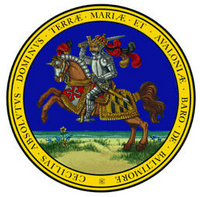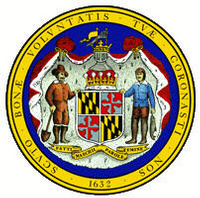|
|
THE GREAT SEAL OF MARYLAND
The Great Seal of Maryland is used by the Governor and the Secretary of State to authenticate Acts of the General Assembly and for other official purposes. The first Great Seal was sent from England shortly after settlement of the colony. With the exception of the period during crown rule (1692-1715), when different seals were used, the first Great Seal remained in use, although slightly altered, until the Revolution. The State of Maryland then adopted a new seal similar in form and spirit to those of other states. One hundred years later, the State of Maryland re-adopted its old seal (Joint Resolution no. 5, Acts of 1876). The reverse of this seal is the only part which has ever been cut. The obverse is still considered part of the seal and is often used to adorn public buildings.


The reverse (at right) consists of an escutcheon, or shield, bearing the Calvert and Crossland arms quartered. Above is an earl's coronet and a full-faced helmet. The escutcheon is supported on one side by a farmer and the other a fisherman. It symbolizes Lord Baltimore's two estates: Maryland, and Avalon in Newfoundland. The Calvert motto on the scroll is "Fatti maschii parole femine," which is usually translated " manly deeds, womanly words." The Latin legend on the border (the last verse of Psalms 5 from the Vulgate) is translated "with favor wilt thou compass us as with a shield." The date, 1632, refers to the year the Maryland charter was granted by Charles I, King of England, to Cecilius Calvert, second Lord Baltimore. The obverse (left) of the Seal shows Lord Baltimore as a knight in full armor mounted on a charger. The inscription translated is "Cecilius, Absolute Lord of Maryland and Avalon, Baron of Baltimore."
Photograph &
article copyright © 1990-2022
by John T.
Marck. All Rights Reserved. This photograph and article may not be resold,
reprinted, or redistributed for compensation of any kind.
A Splendid Time Is Guaranteed
For All